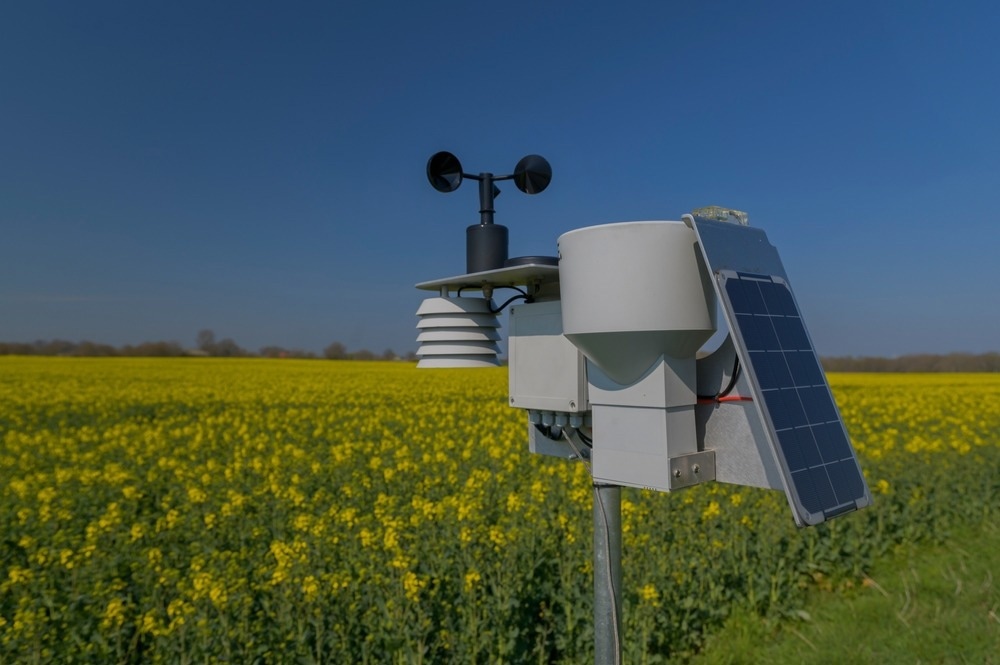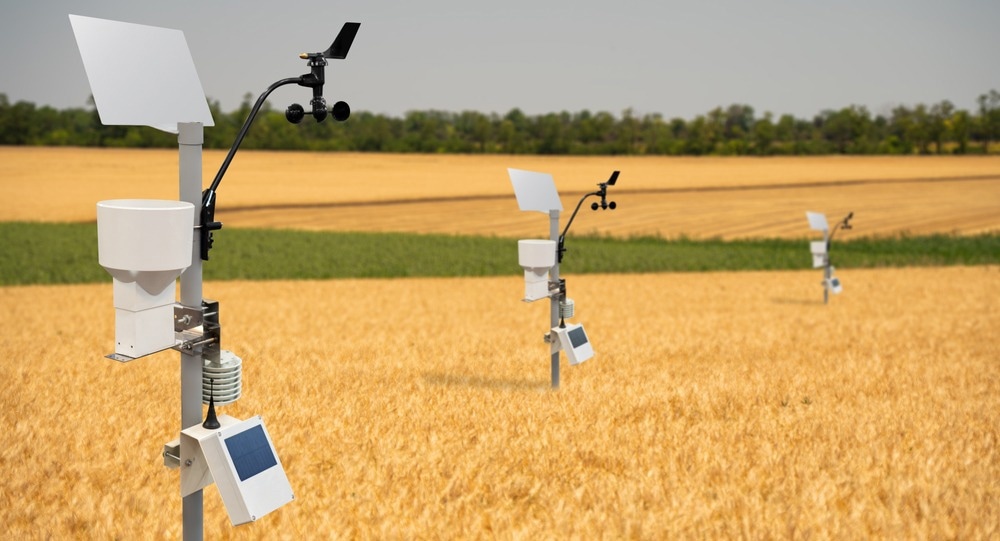Weather conditions play a significant role in determining food production. Monitoring conditions is, therefore, a key aspect of agricultural management; devices can now integrate a wide range of environmental data to inform the best use of resources. Devices are also using more complex technology while also using more cost-effective materials, which will improve the accuracy of forecasts in the face of global climate change.

Image Credit: Frederick Doerschem/Shutterstock.com
The significance of weather monitoring in agriculture
From the smallest areas of cultivation to the largest of farms, the environment is the main driver of crop and animal health, growth, and productivity. One main part of the environment is the weather, which can be defined as an atmospheric phenomenon encompassing ambient temperature, humidity, barometric pressure, precipitation, and wind speed. The umbrella term of “weather,” therefore, describes a range of abiotic conditions often synonymous with terms such as “climate” or just “environment.”
In a 2021 study by Born et al., the authors conducted a meta-analysis of the most impactful climatic factors and surveyed farmers to determine which factors they used most to inform their farming decisions. The study found that temperature, soil moisture, and soil temperature are less frequently used by farmers, who prefer using seasonal precipitation as a forecast variable for decision-making. Weather patterns drive farmers' decision-making, which relies on favorable conditions to maintain productivity.
As a result of the dependency of productivity on favorable weather, regular and accurate weather monitoring is extremely valuable. Over the last century, fixed weather stations are typically used to determine weather conditions, which can then be used to forecast upcoming weather. This forecasting has gradually become more accurate and long-reaching thanks to technological innovations.
Over recent years, smart agriculture systems have been able to be equipped with climatic data monitoring abilities. This allows for real-time control of agricultural systems, including irrigation and watering levels, pesticide or fertilizer usage, and other uses. In turn, weathering monitoring allows stakeholders to prepare, mitigate, and adapt to harsher conditions further in advance, such as periods of drought, heatwaves, or storm events.
The range of weather monitoring tools used in agriculture
Modern agriculture is gradually becoming ‘smarter’ by integrating more automated technologies that can store, monitor, and forecast most climate-related parameters to inform effective land and resource management. Therefore, devices or tools used to monitor atmospheric and other climate-related parameters aim to develop portable, internet-based, wireless data-acquisition systems. Information on current and past weather conditions can therefore be relayed back to inform models and be used to improve the management of agricultural land and resources.
The process from climate monitoring to changes in farm decision-making was further detailed in a 2022 study by Bwambale et al., who reviewed the existing systems to inform irrigation control strategies. The review describes closed-loop and open-loop irrigation methods and how weather can adjust irrigation levels. The authors also highlight that closed-loop systems are more efficient as they have fewer uncertainties in the system.
Alongside the integration of technologies, many researchers are developing more cost-effective devices. Low-cost solutions are discussed by Dombrowski et al., 2021, who evaluated the all-in-one ATMOS41 systems (https://www.metergroup.com/en/meter-environment/products/atmos-41-weather-station). Although the meters showed high performance over time, certain concerns were noted when dealing with the quality of the data gathered.
Nonetheless, weather stations are becoming increasingly accurate, reliable, and cost-effective. For instance, Rajapaksha et al., 2022 developed a handheld palmtop weather station that can measure air temperature, humidity, barometric pressure, dew point, soil moisture level, and carbon monoxide. This allows a broader range of stakeholders to obtain weather monitoring systems that can help improve agricultural practices.

Image Credit: Scharfsinn/Shutterstock.com
Emerging prospects for weather monitoring and potential limitations
The climate monitoring devices currently being released focus on affordable, precise, and usable tools. A 2021 study by Siow and Anas developed a web-based weather monitoring system that uses 3D-printed cases that can be assembled together with an electronic circuit to provide a fully functional monitoring system for agricultural fields. Such tools exemplify the research direction as researchers make climate monitoring more widely available.
Technology also provides more complex, multi-faceted tools that integrate different data types. For instance, environmental sensors detecting pressure, moisture, rain, and temperature, can all be uploaded to platforms such as ThingSpeak, which can then adjust resource use on-site. This eliminates the need for human intervention, solely relying on sensors and web platforms.
However, even with the most accurate climate monitoring systems, the future remains bleak for the role of the environment in agricultural progress. Global climate change is disrupting seasonal patterns, exacerbating climate catastrophes, and intensifying the stress on agricultural stakeholders. This makes weather monitoring even more significant, as farmers will have to mitigate and adapt practices readily under mounting environmental pressure.
Sources:
- Born, L., Prager, S., Ramirez-Villegas, J., & Imbach, P. (2021, April). A global meta-analysis of climate services and decision-making in agriculture. Climate Services, 22, 100231. https://doi.org/10.1016/j.cliser.2021.100231
- Bwambale, E., Abagale, F. K., & Anornu, G. K. (2022, February). Smart irrigation monitoring and control strategies for improving water use efficiency in precision agriculture: A review. Agricultural Water Management, 260, 107324. https://doi.org/10.1016/j.agwat.2021.107324
- Dombrowski, O., Hendricks Franssen, H. J., Brogi, C., & Bogena, H. R. (2021, January 22). Performance of the ATMOS41 All-in-One Weather Station for Weather Monitoring. Sensors, 21(3), 741. https://doi.org/10.3390/s21030741
- Jagatheesan, M., Janaki, G., 2022. Weather Monitoring System using IoT for Smart Farming. ECS Transactions 107, 17439–17445. https://doi.org/10.1149/10701.17439ecst
- Rajapaksha, T. T., Alexander, A., Fernando, L., Than, A., & Nguyen, H. L. (2021, November 27). Real-Time Weather Monitoring and IoT-Based Palmtop Device for Smart Agriculture. SN Computer Science, 3(1). https://doi.org/10.1007/s42979-021-00961-6
- Siow, W. H., & Anas, S. A. (n.d.). Connected Bricks: Designing 3D-Printed EnvironmentalWeatherMonitoring System for Agriculture. Proceedings of Innovation and Technology Competition, 153–154.
Further Reading
Last Updated: Nov 28, 2022